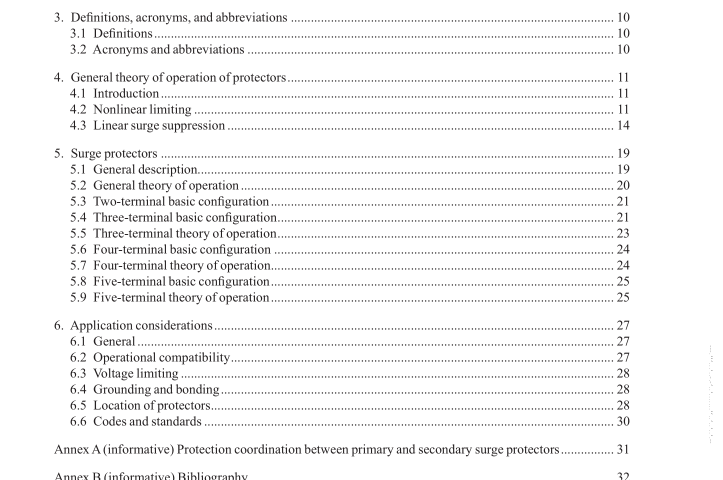IEEE C62.43.0-2017 pdf download.IEEE Guide for Surge Protectors and Protective Circuits Used in Information and Communications Technology Circuits, Including Smart Grid Data Networks—Overview
4. General theory of operation of protectors
4.1 Introduction Both nonlinear and linear characteristic components can be used in surge protective devices (SPDs) (synon- ymous with surge protector) for surge mitigation.
In SPDs, the most commonly used components are of the nonlinear type. Nonlinear components have a set threshold level, beyond which the characteristic rapidly changes to provide a limiting function. Figure 1 shows the various types of surge mitigation function and the surge type they mitigate against. The left side of the fgure shows nonlinear functions and the right side shows linear attenuating functions. Some functions can used to mitigate common-mode and diferential-mode surges, while others are limited to difer- ential-mode or common-mode surges. Subclauses 4.2 and 4.3 give a brief explanation of the fgure blocks.
4.2 Nonlinear limiting
4.2.1 General
These devices are used on electronic equipment where voltage and current surges on the signal line can cause system malfunction or failure.
The devices have two distinct states. In the quiescent state, they are essentially transparent to the system; in the operated state, they provide voltage limiting, current limiting, or both.
The devices are operated or self-triggered by the voltage or current surge and may also self-reset to their quiescent state.
Surge protectors may contain voltage-limiting devices, which are connected in parallel with the terminals to be protected. They may also contain current-limiting devices in series with the terminals to be protected.
Numerous combinations of series and parallel components can be contained in surge protectors, and a comprehensive characterization is too complex to describe completely in this guide. Therefore, several examples of these combinations are given in 5.2 through 5.9 to describe these protectors and to illustrate how internal component interactions occur. This information is organized according to the six basic confgurations defned in IEEE Std C62.36. (These confgurations are illustrated in Figure 11.) Some of the description and theory of operation discussed in Clause 4 is common to many or all of these various confgurations.
Nonlinear limiters have two types of characteristic: discontinuous (switching) and continuous (clamping), as shown in Figure 2 and Figure 3, together with their limiting action on surges. There are technology variants on the generic characteristic. In Figure 2, the gray line represents a GDT voltage-limiting characteristic. In Figure 3, the foldback characteristic applies only to voltage limiters, and the re-entrant characteristic applies only to current limiters.
4.2.2 Overvoltage limiting Voltage-limiting components draw little current until the voltage exceeds the predetermined threshold voltage of the component.
4.2.2.1 Discontinuous characteristic voltage limiting These components use solid-state materials or gases. Figure 2 shows the voltage/current (V-I) characteristics for a solid-state thyristor and a gas discharge tube (GDT). The V-I characteristic is not continuous but has a break or breaks where switching occurs (IEEE Std C62.31-2006 [B16] and IEEE Std C62.37-1996 [B19]).
4.2.2.2 Continuous characteristic voltage limiting
These components use solid-state materials. Metal-oxide varistors (MOVs) use the properties of sintered material and silicon semiconductor components use the properties of PN-junctions. All components have a clamping V-I characteristic, but the clamping characteristic varies with technology (IEEE Std C62.33-1982 [B17] and IEEE Std C62.35 [B18]) (see Figure 3).
4.2.3 Overcurrent limiting Current-limiting components develop comparatively little voltage until the current exceeds the predetermined threshold current of the component (IEEE Std C62.39-2012 [B20]).
4.2.3.1 Discontinuous characteristic current-limiting These components can be electronic circuits, called electronic current limiters (ECLs), or one-operation com- ponents like fuses. The V-I characteristic is not continuous but has a break where switching occurs. Unlike fuses, ECLs operate under impulse conditions (Laur et al. [B27]).
4.2.3.2 Continuous characteristic current-limiting These components can be electronic circuits or materials whose resistance increases with the temperature rise caused by self-heating. Electronic circuits can be made with constant current or re-entrant characteristics (Sanchez et al. IEEE C62.43.0 pdf download.IEEE C62.43.0-2017 pdf download
IEEE C62.43.0-2017 pdf download

Leave a Reply